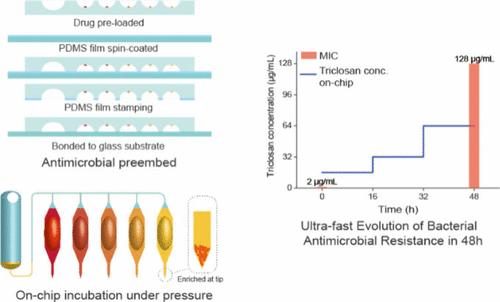当前位置:
X-MOL 学术
›
Anal. Chem.
›
论文详情
Our official English website, www.x-mol.net, welcomes your
feedback! (Note: you will need to create a separate account there.)
Ultrafast Evolution of Bacterial Antimicrobial Resistance by Picoliter-Scale Centrifugal Microfluidics
Analytical Chemistry ( IF 6.7 ) Pub Date : 2024-11-12 , DOI: 10.1021/acs.analchem.4c04482 Teng Xu, Yajie Dai, Anle Ge, Xueqian Chen, Yanhai Gong, Tze Hau Lam, Kelvin Lee, Xiao Han, Yuetong Ji, Wei Shen, Jiquan Liu, Luyang Sun, Jian Xu, Bo Ma
Analytical Chemistry ( IF 6.7 ) Pub Date : 2024-11-12 , DOI: 10.1021/acs.analchem.4c04482 Teng Xu, Yajie Dai, Anle Ge, Xueqian Chen, Yanhai Gong, Tze Hau Lam, Kelvin Lee, Xiao Han, Yuetong Ji, Wei Shen, Jiquan Liu, Luyang Sun, Jian Xu, Bo Ma

|
Experimental evolution is a powerful approach for scrutinizing and dissecting the development of antimicrobial resistance; nevertheless, it typically demands an extended duration to detect evolutionary changes. Here, a centrifugal microfluidics system is designed to accelerate the process. Through a simple step of on-chip centrifugation, a highly condensed bacterial matrix of ∼1012 cells/mL at the enrichment tip of the chip channel is derived, enabling bacteria encapsulated to survive in antimicrobial concentrations several times higher than the minimum inhibitory concentration (MIC) and rapidly develop resistance in the first 10 h. After 48 h of on-chip evolution, the E. coli strain demonstrated a 64 to 128-fold reduction in sensitivity to disinfectants (triclosan) as well as antibiotics (ciprofloxacin and amikacin), a rate substantially swifter compared to conventional continuous inoculation-based experimental evolution. The speed and simplicity of this microfluidic system suggest its broad application for uncovering resistance mechanisms and identifying targets of biocides and antibiotics.
中文翻译:

皮升级离心微流体技术细菌抗菌素耐药性的超快进化
实验进化是仔细检查和剖析抗菌素耐药性发展的有力方法;然而,它通常需要更长的持续时间来检测进化变化。在这里,离心微流体系统被设计来加速这一过程。通过简单的芯片离心步骤,在芯片通道的富集尖端得到 ∼1012 个细胞/mL 的高度浓缩细菌基质,使封装的细菌能够在比最低抑菌浓度 (MIC) 高出几倍的抗菌浓度下存活,并在前 10 小时内迅速产生耐药性。芯片进化 48 小时后,大肠杆菌菌株对消毒剂(三氯生)和抗生素(环丙沙星和阿米卡星)的敏感性降低 64 至 128 倍,与传统的基于连续接种的实验进化相比,这一速度要快得多。这种微流体系统的速度和简单性表明其在揭示耐药机制和识别杀菌剂和抗生素靶标方面的广泛应用。
更新日期:2024-11-13
中文翻译:

皮升级离心微流体技术细菌抗菌素耐药性的超快进化
实验进化是仔细检查和剖析抗菌素耐药性发展的有力方法;然而,它通常需要更长的持续时间来检测进化变化。在这里,离心微流体系统被设计来加速这一过程。通过简单的芯片离心步骤,在芯片通道的富集尖端得到 ∼1012 个细胞/mL 的高度浓缩细菌基质,使封装的细菌能够在比最低抑菌浓度 (MIC) 高出几倍的抗菌浓度下存活,并在前 10 小时内迅速产生耐药性。芯片进化 48 小时后,大肠杆菌菌株对消毒剂(三氯生)和抗生素(环丙沙星和阿米卡星)的敏感性降低 64 至 128 倍,与传统的基于连续接种的实验进化相比,这一速度要快得多。这种微流体系统的速度和简单性表明其在揭示耐药机制和识别杀菌剂和抗生素靶标方面的广泛应用。


















































 京公网安备 11010802027423号
京公网安备 11010802027423号